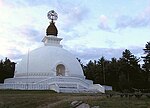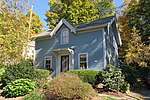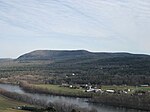Rattlesnake Gutter
Landforms of Franklin County, MassachusettsMassachusetts geography stubsOpen space reserves of MassachusettsProtected areas of Franklin County, MassachusettsRock formations of Massachusetts

Rattlesnake Gutter is a scenic boulder filled chasm, 3/4 mile long and 1/8 mile wide, located in Leverett, Massachusetts. The origins of the gutter are uncertain, but theories include: A subglacial meltwater channel A tear at the site of an old geologic fault. A spillway for a temporary proglacial lake.An important ecological habitat, the property is under conservation stewardship. The Metacomet-Monadnock Trail passes near the gutter.
Excerpt from the Wikipedia article Rattlesnake Gutter (License: CC BY-SA 3.0, Authors, Images).Rattlesnake Gutter
Montague Road,
Geographical coordinates (GPS) Address Nearby Places Show on map
Geographical coordinates (GPS)
| Latitude | Longitude |
|---|---|
| N 42.473888888889 ° | E -72.496944444444 ° |
Address
Montague Road 157
01054
Massachusetts, United States
Open on Google Maps






